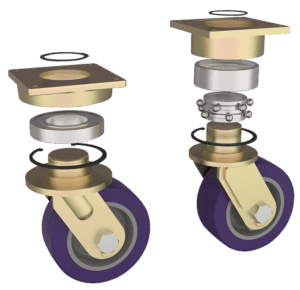

Although we manufacture high-grade casters that start at weight capacities less than 900lbs., we have built a reputation in the custom caster arena and in the heavy duty realm. These casters conform to ICWM standards and can carry more than 5,000 pounds in an industrial or demanding environment.
And when we say “more than” think much more. As in heavy duty, extra heavy duty, and super heavy duty, with capacities going over 250,000lbs. per caster.
This starts with our 80 series casters, with wheel diameters ranging from 6″x3″ and up. They can be dual-wheel casters or single casters featuring reinforced legs.
A Dual Wheel Caster is ideal for powered moving instead of manual pushing with a capacity of 50,000 pounds. A good example is our 99 HD Series Dual Wheel. Benefits include:

97 and 97HD Series Caster
Heavy duty casters are designed to take abuse and keep on rolling. That’s why they are constructed with premium materials to handle these demanding applications. The wheel cores are either solid steel or grey iron. High-grade urethanes are used for the tire material and are designed to withstand high loads and high speeds. The swivel sections are forged and heat treated – not stamped. In addition, high-strength ball bearings and high-grade, extra tacky greases are used.
There is a lot of interest regarding a spring load in large industrial applications. When using these types of casters, it’s important to understand how much your caster is going to deflect under load. Spring deflection is the travel distance between the loaded position and the pre-loaded position of the spring.
Once you know the proper deflection, spring-loaded shock-absorbing casters offer many benefits. For example, our Series 103 HD Spring Loaded Swivel Caster can handle loads up to 20,000lbs. The springs minimize the impact the cart undergoes with a heavy load and cushion the load on an uneven floor. Spring-loaded casters also offer the ability to deflect under a heavy load so a cart’s feet can touch the floor and support the load. To learn more about the many spring-loaded casters we offer, click here.
With heavier loads and more demanding applications, many situations can lead to caster failure. Avoiding or minimizing these situations can help ensure your casters last longer and perform to spec.
Excessive Speed: As speed increases, so does the load’s impact on the caster when traveling over expansion joints or other obstructions. This impact can permanently deform the swivel section raceways or even damage the wheel or caster legs.
Excessive speed can also lead to premature failure of polyurethane tires due to the extra heat generated from a higher frequency of material deflection.
Rough Terrain: In addition to the similar effects of excessive speeds, Rough terrain can also cause polyurethane and other soft tires to chunk out and fail prematurely. When using casters over rough terrain, it is best to design the caster with a level of shock-absorbing capability.
Excessive Temperatures: When operating temperatures begin to exceed 100°F, wheel material selection becomes important as softer materials will tend to flat spot or even melt. As the temperature continues to increase, grease selection is also critical, as the wrong type of grease can liquify, greatly increasing the chances of bearing or swivel section failure.
Finding the right heavy-duty caster for your application does not have to be a difficult and lengthy process. You can view casters by industry, use our Custom CAD Configurator, or contact us by email or phone. We’re here to help you get the information you need.